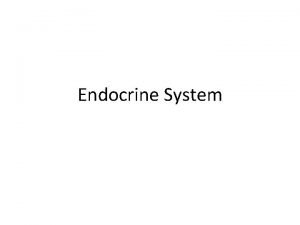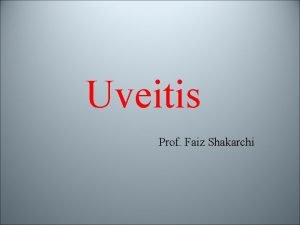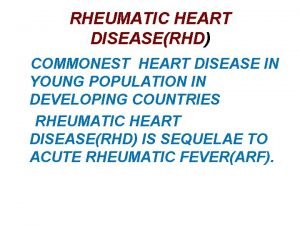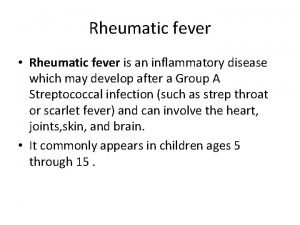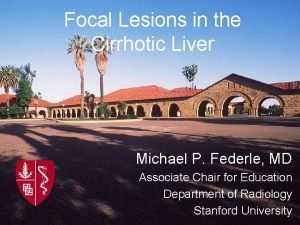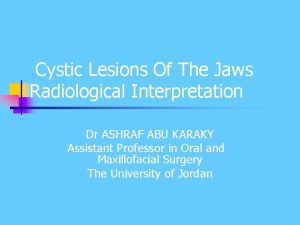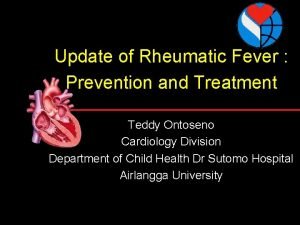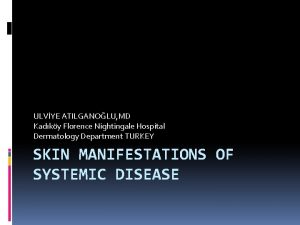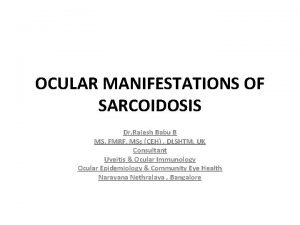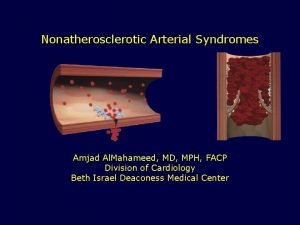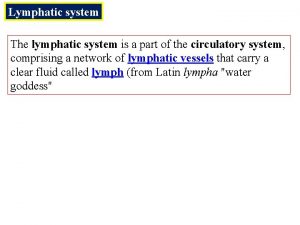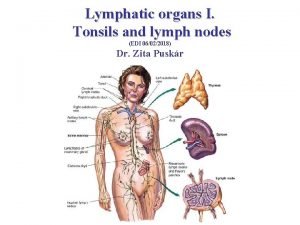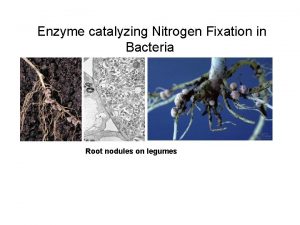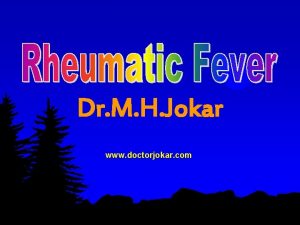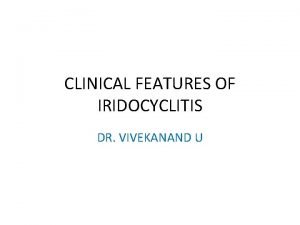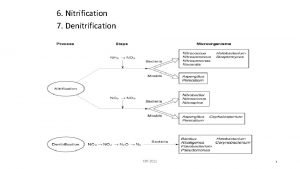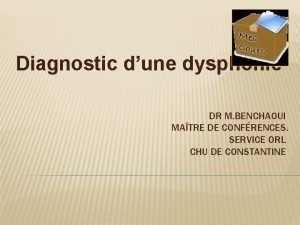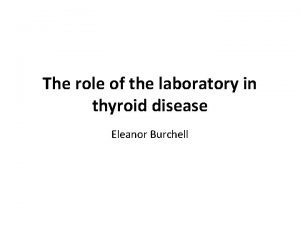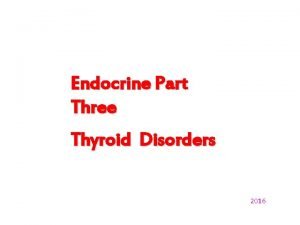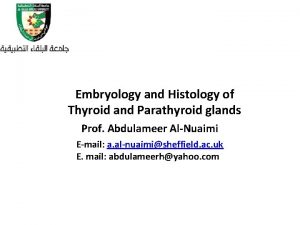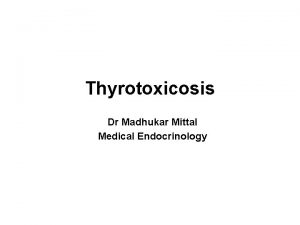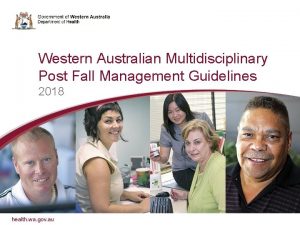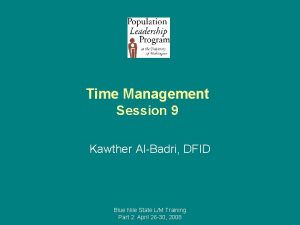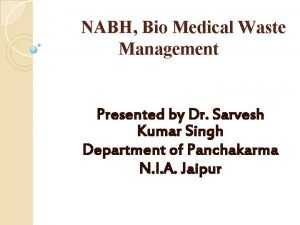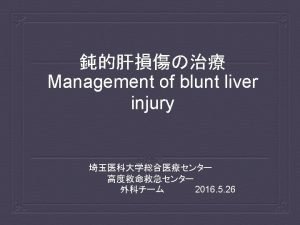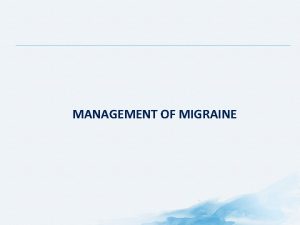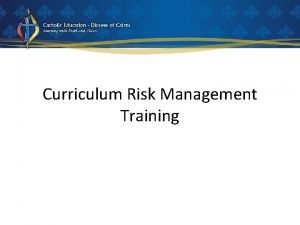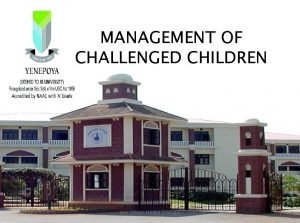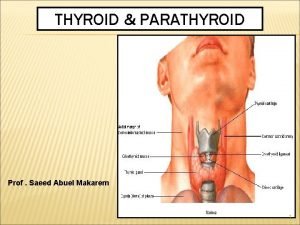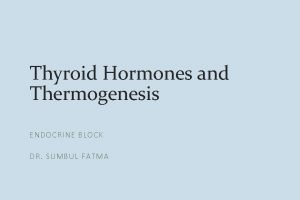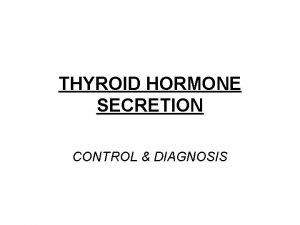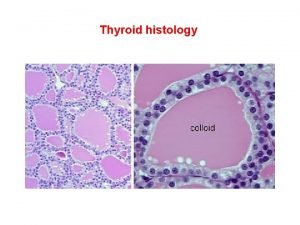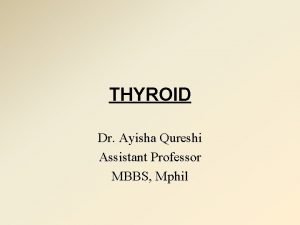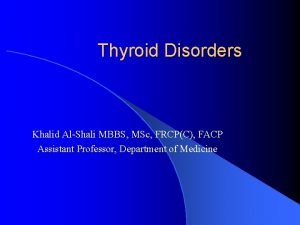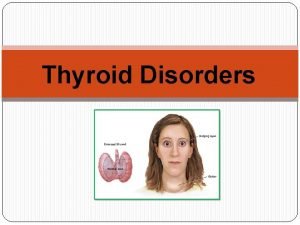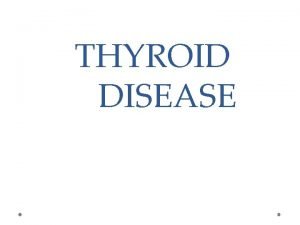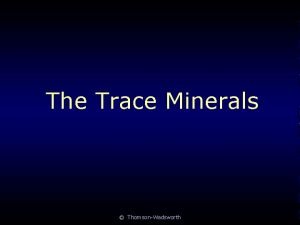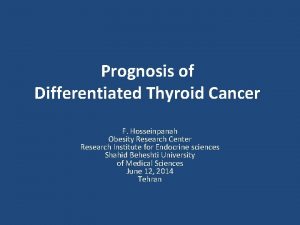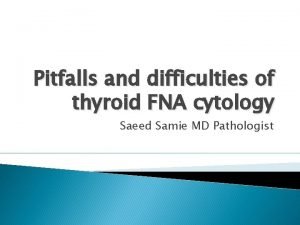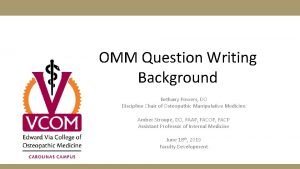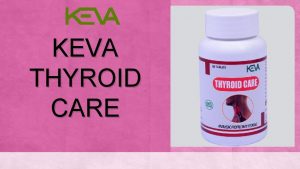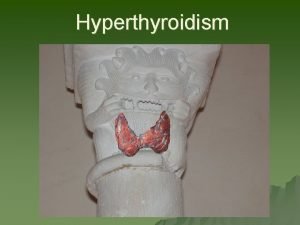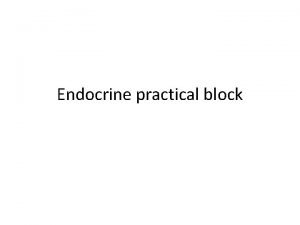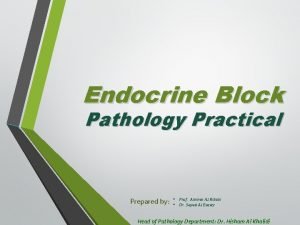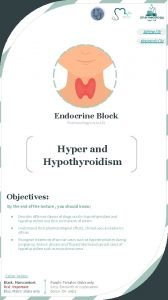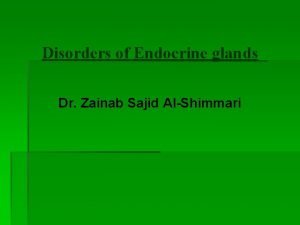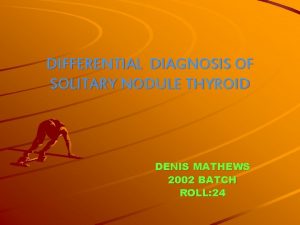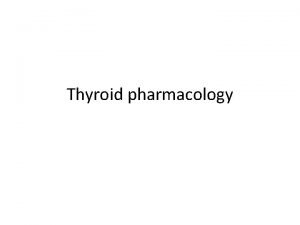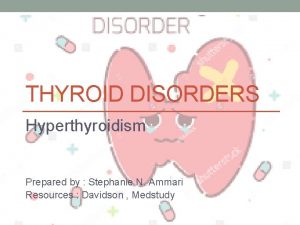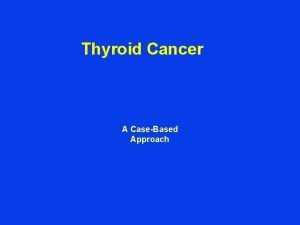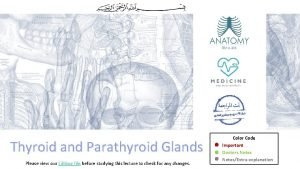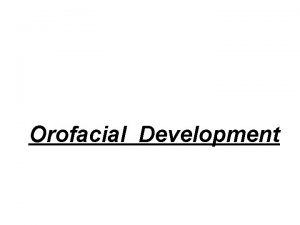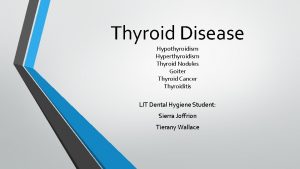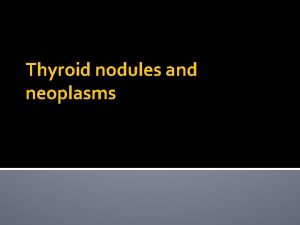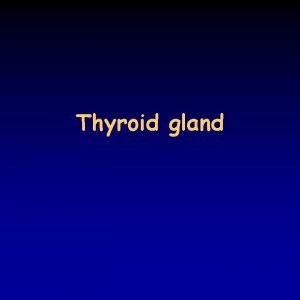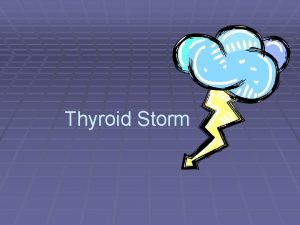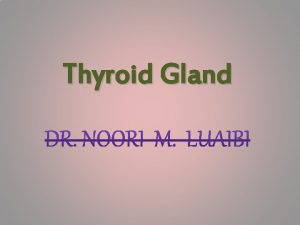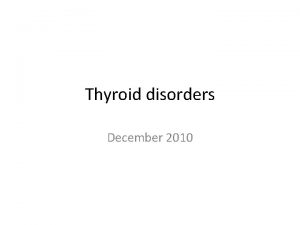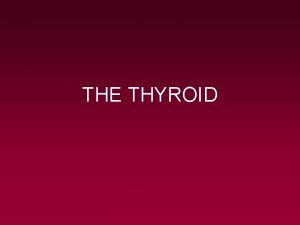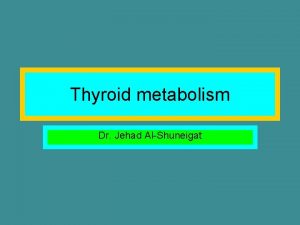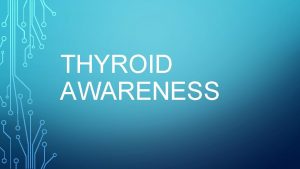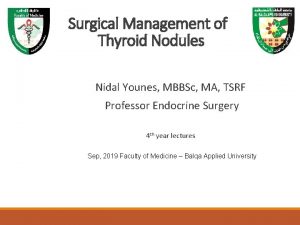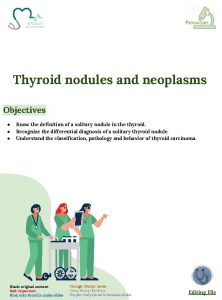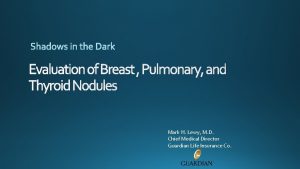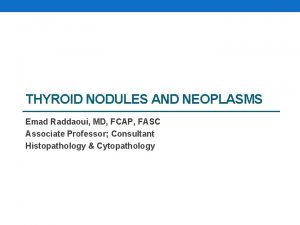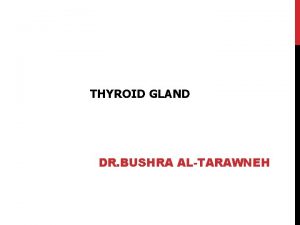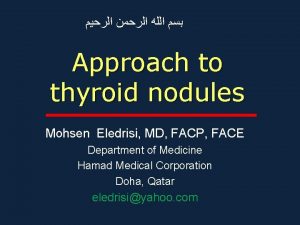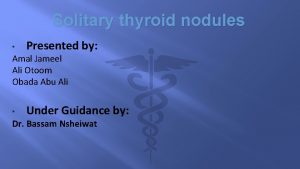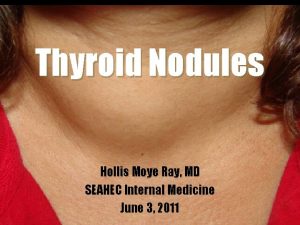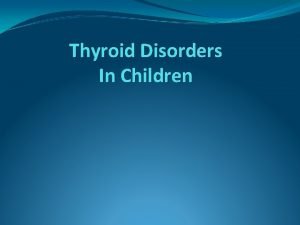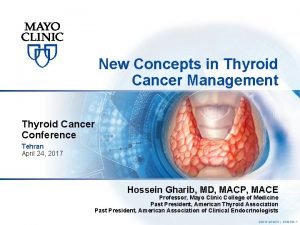Management Guidelines for Children with Thyroid Nodules and






























































































![• SURVEILLANCE AND FOLLOW UP OF PTC IN CHILDREN [D 2] WHAT IS • SURVEILLANCE AND FOLLOW UP OF PTC IN CHILDREN [D 2] WHAT IS](https://slidetodoc.com/presentation_image_h/a8f91091c3f0f4a55f117858545af207/image-95.jpg)












































- Slides: 139


Management Guidelines for Children with Thyroid Nodules and Differentiated Thyroid Cancer ATA 2015 Bita mirzaei MD Endocrine Fellow Shahid Beheshti University Of Medical Science Tir 1394 – JUNE 2015

Agenda : • Introduction • Background • Thyroid nodule guidelines • Papillary thyroid cancer-initial management guidelines • Follicular thyroid cancer

Agenda : • Introduction • Background • Thyroid nodule guidelines • Papillary thyroid cancer-initial management guidelines • Follicular thyroid cancer


INTRODUCTION • The American Thyroid Association (ATA), the American Association of Clinical Endocrinologists (AACE), the National Comprehensive Cancer Network (NCCN), and the British Thyroid Association/Royal College of Physicians, previously published guidelines specifically addressing the evaluation, treatment and followup of thyroid nodules and DTC in adults. • In most cases, the evaluation, treatment and follow-up of children with thyroid neoplasia have followed adult guidelines

• Heretofore, this approach resulted in a high proportion of cure, but required all children to undergo therapy that included total thyroidectomy followed by radioactive iodine (RAI) ablation with iodine-131. Unfortunately, recent studies with follow-up spanning several decades reveal an increase in all-cause mortality for survivors of childhood DTC, predominately due to second malignancies in children treated with radiation. • These observations, coupled with a better understanding of the excellent prognosis associated with pediatric DTC, have now prompted the ATA to specifically address treatment of children with benign and malignant thyroid tumors. •

Agenda : • Introduction • Background • Thyroid nodule guidelines • Papillary thyroid cancer-initial management guidelines • Follicular thyroid cancer

Background • New Cases of thyroid cancer in people < age 20 represent 1. 8% of all thyroid malignancies diagnosed in the United States. • Unfortunately, the incidence appears to be increasing. • Among 15 -19 year old adolescents, thyroid cancer is the 8 th most frequently diagnosed cancer and the second most common cancer among girls. • Adolescents have a 10 -fold greater incidence than younger children and there is a female: male preponderance (5: 1) during adolescence that is not seen in young children.

• The most common presentation for DTC in children is that of a thyroid nodule. • However, papillary thyroid cancer (PTC) also frequently presents as cervical adenopathy with or without a palpable thyroid lesion. • as an incidental finding after imaging or surgery for an unrelated condition. • Occasionally, the diagnosis is made only after the discovery of distant metastases.

• The pathological classification of differentiated thyroid cancers in children is based on standard definitions set by WHO, with histological criteria the same for children and adults. • PTC accounts for 90% or more of all childhood cases. • Follicular thyroid cancer (FTC) is uncommon while medullary thyroid cancer (MTC), poorly differentiated tumors and frankly undifferentiated (anaplastic) thyroid carcinomas are rare in young patients.

• Subtypes of PTC in pediatrics include the following histologic variants: classic, solid, follicular and diffuse sclerosing. • Children, especially those < 10 years of age, may not have the classic papillary morphology as seen in adults and such tumors can be: un-encapsulated, widely-invasive throughout the gland, and have a follicular and solid architecture with unique nuclear features and abundant psammoma bodies.

• The major risk factor for developing PTC is radiation exposure to the thyroid Children, especially those < 5 years of age, are the most sensitive. • Radiation-induced PTC does not appear to differ in clinical behavior when compared to sporadic PTC. • Activation of the RAS-RAF-MEK-ERK (mitogen-activated protein kinase) pathway is critical for thyroid malignancies. • An estimated 5% of patients with non-medullary thyroid cancer (NMTC) have a family history of nonsyndromic NMTC with conflicting evidence in regard to whether it behaves more aggressively.

• PTC and FTC exhibit major clinical differences: • PTC is frequently multifocal and bilateral and metastasizes to regional neck lymph nodes in the vast majority of children. • Hematogenous metastases to the lungs occur in up to 25% of cases and generally occur only with significant regional lymph node metastases. • FTC is typically a unifocal tumor and more prone to initial hematogenous metastases to lungs and bones. Metastases to regional lymph nodes are uncommon in FTC. • Histologic variants of FTC include: Hürthle cell (oncocytic), clear cell, and insular (poorly differentiated) carcinoma.

• Based on the rarity of FTC in children and the major clinical and biological differences between PTC and FTC in children, the current guidelines have been developed specifically for PTC in children and have chosen to include a separate section dedicated to the treatment of FTC.

WHY DO WE NEED SPECIFIC GUIDELINES FOR CHILDREN WITH THYROID NODULES AND THYROID CANCER? • There are important clinical, molecular and pathological differences in DTC among children when compared to adults that prompt the development of unique pediatric guidelines. • From a clinical perspective, thyroid nodules are uncommon in children. • there is a greater risk of malignancy in nodules diagnosed in children compared with adults (2226% versus 5 -10% in most series)

• Second, children with PTC are more likely to have regional lymph node involvement, extra-thyroidal extension, and pulmonary metastasis. • Third, despite extensive disease at clinical presentation, children are much less likely to die from disease (2% or less long-term cause-specific mortality) than are adults), and many children with pulmonary metastases (30 - 45%) develop persistent albeit stable disease following 131 I therapy. Finally, there may be a continued clinical response demonstrated by a decline in Tg levels after cessation of RAI therapy in children with pulmonary metastases

• Compared with adult PTC, childhood PTC is characterized by a higher prevalence of gene rearrangements and a lower frequency of point mutations in PTC. • Recent molecular studies have shown that BRAF mutations are the most common abnormality in adult PTC (36 -83% of cases)), but they are rare in children with PTC and virtually absent from the youngest patients. • This may be important because point mutations of RAS and BRAF lead to genomic instability and dedifferentiation manifested by decreased expression of the sodiumiodide symporter (NIS)

• In contrast, RET/PTC rearrangements are more common in PTC from children and do not lead to genomic instability. • These molecular differences might be one of the reasons for better response to RAI therapy in children with PTC and could partially explain their low mortality and rare progression to less-differentiated tumors.

• TO WHAT AGE GROUP SHOULD THESE GUIDELINES APPLY?

• RECOMMENDATION 1: • The pediatric age should be limited to a patient ≤ 18 years of age. • Establishing a uniform upper limit of age will afford an opportunity to better define the potential impact of growth on tumor behavior. From a pragmatic point of view, individual centers may transition pediatric patients to adult care anywhere between 18 to 21 years of age. Clinicians may manage the “child” under these guidelines until transition has been completed. Recommendation rating: C

• SHOULD TREATMENT OF CHILDREN WITH DTC BE STRATIFIED INTO MORE THAN ONE AGE GROUP? RECOMMENDATION 2: • It remains unclear if younger children are at greater risk for more extensive disease or higher rates of recurrence. • Other factors aside from age (treatment approaches, genetic susceptibility, and/or radiation exposure) may interact to modify this risk. However, those studies with a larger proportion of young children show an increased risk of persistent disease/recurrence.

• the committee recommends that “prepubertal” and “pubertal/postpubertal” should be incorporated into future studies to increase uniformity and more accurately represent the potential influence of pubertal development on the incidence and behavior of DTC within the pediatric population • Recommendation rating: B

• RECOMMENDATION 3: • Children with DTC should be cared for by teams of physicians experienced in the management of DTC in children. • This will facilitate interdisciplinary decisions regarding optimal therapy and will help to reduce the possibility that treatment and long-term follow up will be either overly aggressive or inadequate. • Recommendation rating: C

Agenda : • Introduction • Background • Thyroid nodule guidelines • Papillary thyroid cancer-initial management guidelines • Follicular thyroid cancer

THYROID NODULE GUIDELINES Thyroid nodules are less common among children than adults but are more likely to be malignant in children referred for evaluation of nodular thyroid disease (22 -26% versus approximately 5%) Estimates from ultrasound (US) and post mortem examination suggest that 1 – 1. 5% of children and up to 13% of older adolescents or young adults have thyroid nodules although it is unclear how many of these would have become clinically apparent

• ARE THERE HIGH-RISK GROUPS WHO MIGHT BENEFIT FROM PROSPECTIVE SCREENING FOR THYROID NODULES AND THYROID CANCER?

• Several risk factors are associated with the development of thyroid nodules in children, including: • iodine deficiency • prior radiation exposure • a history of antecedent thyroid disease • several genetic syndromes (Table 4). • Many of which can only be detected by US, develop in cancer survivors at a rate of about 2 % annually and reach a peak incidence 15 to 25 years after exposure. In general the risk is greatest among those who received radiation therapy at a younger age and with doses up to 20 -29 Gy.


• RECOMMENDATION 4(A): An annual physical exam is recommended in children at high risk for thyroid neoplasia. Additional imaging should be pursued if palpable nodules, thyroid asymmetry and/or abnormal cervical lymphadenopathy are found on exam. Recommendation rating: B

• RECOMMENDATION 4(B): • In children with a history of radiation exposure to the thyroid, the data show that US can detect small thyroid nodules but the panel is not yet convinced that detection of subclinical disease by US prior to a palpable abnormality on physical exam impacts long-term outcomes • Therefore, routine screening US in high-risk children can neither be recommended for nor against until more data become available. Recommendation rating: I

• RECOMMENDATION 4(C): • Patients at increased risk of developing familial DTC should be referred to centers of excellence so that appropriate evaluation, follow-up, genetic counseling and/or treatment can be undertaken without subjecting patients and families to unwarranted and aggressive therapy. Recommendation rating: C

• RECOMMENDATION 4(D): For patients with autoimmune thyroiditis, evaluation by an experienced thyroid ultrasonographer should be pursued in any patient with a suspicious thyroid examination (suspected nodule or significant gland asymmetry), especially if associated with palpable cervical lymphadenopathy. Recommendation rating: B

• WHAT IS THE OPTIMAL EVALUATION OF CHILDREN WITH THYROID NODULES? • The 2009 adult guidelines indicate that FNA is not warranted for the evaluation of a nodule less than 1 cm in size unless the patient is considered high-risk, most commonly with a history of exposure to ionizing radiation, or the nodule is associated with pathologic regional lymph nodes • A size criterion is more problematic in children because thyroid volume changes with age and the size of the nodule alone does not predict malignant histology

• Therefore, US characteristics and clinical context should be used more preferentially to identify nodules that warrant FNA. • US features such as hypoechogenicity, irregular margins, and increased intranodular blood flow are more common in malignant lesions • In addition, the presence of microcalcifications and abnormal cervical lymph nodes increase the likelihood of malignancy • In all children with a suspicious nodule, US evaluation of the cervical lymph nodes should be performed.

• The 2009 adult guidelines indicate that FNA is not warranted for the evaluation of a hyperfunctioning nodule in the adult. • Although we concur that pre-operative FNA of a hyperfunctioning nodule in a child is similarly not warranted, this is based on the understanding that all hyperfunctioning nodules in children will be surgically removed

• The 2009 adult guidelines indicate that calcitonin screening for MTC in adults with thyroid nodules may be costeffective but it was neither recommended for nor against. • In children and adolescents, the prevalence of sporadic MTC is extremely low. In addition, calcitonin reference ranges in children have not yet been widely validated, especially in children who have background thyroid disease such as thyroiditis. • Further studies are needed in order to determine the costeffectiveness of adding calcitonin to the evaluation of thyroid nodules in children.

• The sensitivity, specificity, and overall accuracy of FNA in children are similar to that of adults However, based on the higher proportion of malignant nodules in children and the potential difficulty in obtaining repeat samples from children, this task force recommends that all FNA in children should be performed with US guidance • This is particularly relevant for complex cystic lesions, which require FNA of the solid portion, and it may also reduce the need for repeat FNA. The latter is important since FNA may alter the ultrasonographic features of thyroid nodules), thus making short term follow-up more difficult.

• A unique but very important difference in children is that PTC may present as diffusely infiltrating disease that results in diffuse enlargement of a lobe or the entire gland. • For this reason, diffuse thyroid enlargement, especially if associated with palpable cervical lymph nodes, should prompt imaging. • With rare exception, the diffuse infiltrating form of PTC is associated with microcalcifications that warrant FNA.

• In adults, the risk of malignancy in indeterminate nodules ranges from ~5 -15% in the AUS/FLUS category to 15 -30% in the follicular neoplasm or suspicious for neoplasm group. • The limited data available suggest these indeterminate FNA categories account for ~35% of pediatric FNA and that, in children, 28% of AUS/FLUS lesions and 58% of suspicious for follicular or Hürthle cell neoplasm are malignant.

• The 2009 adult guidelines suggested that repeat FNA was an option for adults with indeterminate cytopathology. • However, due to the apparent increased probability of malignancy among these indeterminate categories in children, the task force recommends definitive surgery (lobectomy + isthmusectomy) for indeterminate FNA findings in children (see Figure 1).


• RECOMMENDATION 5 : • The evaluation and treatment of thyroid nodules in children should be the same as in adults with the exceptions that: • 1. US characteristics and clinical context should be used rather than size alone to identify nodules that warrant FNA • 2. All FNA in children should be performed under US-guidance • 3. Preoperative FNA of a hyperfunctioning nodule in a child is not warranted as long as the lesion is removed • 4. A diffusely infiltrative form of PTC may occur in children and should be considered in a clinically suspicious gland, and • 5. Surgery (lobectomy + isthmusectomy) is favored over repeat FNA for most nodules with indeterminate cytology. • Recommendation rating: B

• ARE THERE MOLECULAR SIGNATURES THAT COMPLEMENT FNA AND IMPROVE THE DIAGNOSTIC UTILITY OF FNA IN CHILDREN?

• RECOMMENDATION 6: • A positive mutational test appears highly likely to be associated with malignancy. • Conversely, insufficient data exist in children to rely on negative genetic studies to reliably exclude malignancy. Although molecular studies hold promise for complementing the results of FNA, particularly for nodules that yield indeterminate cytology, they have not yet been sufficiently validated in children and cannot be routinely recommended in routine clinical practice until further studies are conducted. • Recommendation rating: E

• HOW SHOULD THYROID NODULES BE TREATED IN CHILDREN? • The surgical approach to the child with a thyroid nodule is dictated by the FNA results

• WHAT IS THE RECOMMENDED APPROACH FOR CHILDREN WITH BENIGN THYROID CYTOPATHOLOGY? A key element in this question is whether or not “benign” lesions in children as defined by absence of suspicious US findings and benign FNA are ever subsequently found to be malignant. • There are insufficient data to answer this question in children, but there are studies that have included both children and adults The false negative rate appears to be quite low, in the range of 3 -5% however, the false negative rate may be higher in larger lesions secondary to an increased risk of sampling error.

• IS THERE A ROLE FOR LEVOTHYROXINE SUPPRESSION THERAPY? • RECOMMENDATION 7: • We are unable to recommend for or against the routine use of LT 4 therapy for children with benign thyroid nodules. In general, the data support the efficacy of LT 4 therapy to reduce the size and risk of subsequent nodule formation but there are no data to weigh this potential benefit against the potential risks of long-term suppression therapy. In patients with compressive symptoms or a history of radiation exposure the benefits of LT 4 therapy may be more apparent. • Recommendation rating: I

• IS THERE A ROLE FOR SURGERY IN CHILDREN WITH BENIGN NODULES? • RECOMMENDATION 8 : • Benign lesions should be followed by serial US and undergo repeat FNA if suspicious features develop or the lesion continues to grow. • Lobectomy may be performed in patients with compressive symptoms, cosmetic concerns, or patient/parent preference and should be considered in all apparently benign solid thyroid nodules > 4 cm, those lesions demonstrating significant growth, or in the presence of other clinical concerns for malignancy. • Recommendation rating: B

• WHAT IS THE OPTIMAL MANAGEMENT OF THE CHILD WITH AN AUTONOMOUS THYROID NODULE? • In adults, the treatment options for autonomous nodules include 131 I ablation, surgical resection, or ethanol injection. • Because of concerns of the mutagenic effect of low-activity radioiodine on the normal thyroid tissue, and reports that up to 1/3 rd of patients may be found to have an incidentally discovered DTC associated with autonomous nodules surgical resection is the usual recommendation for most pediatric patients because the safety of observation or alternative treatments is unstudied in children. • However, in asymptomatic patients with an autonomous nodule and subclinical hyperthyroidism, surgery may be deferred, but FNA should be considered if the nodule has features suspicious for PTC.

• RECOMMENDATION 9: For pediatric patients with a suppressed TSH associated with a thyroid nodule, thyroid scintigraphy should be pursued. Increased uptake within the nodule is consistent with autonomous nodular function. Surgical resection, most commonly lobectomy, is the recommended approach for most autonomous nodules in children and adolescents. Recommendation rating: A




Agenda : • Introduction • Background • Thyroid nodule guidelines • Papillary thyroid cancer-initial management guidelines • Follicular thyroid cancer

• WHAT IS THE OPTIMAL PRE-OPERATIVE EVALUATION FOR THE CHILD WITH NEWLY DIAGNOSED PTC?

• RECOMMENDATION 10 A: • comprehensive neck US to interrogate all regions of the neck is required in order to optimize the preoperative surgical plan. • FNA of suspicious lateral neck lymph nodes is recommended. • Anatomic imaging by MRI or CT with contrast should be considered in patients with large or fixed thyroid masses, vocal cord paralysis, or bulky metastatic lymphadenopathy in order to optimize surgical planning. • Recommendation rating: A

• WHAT IS THE RECOMMENDED SURGICAL APPROACH FOR THE PATIENT WITH A DIAGNOSIS OF PTC? • RECOMMENDATION 11: • For the majority of children, total thyroidectomy is recommended. The rationale for this approach is based on multiple studies showing an increased incidence of bilateral and multi-focal disease. In long-term analysis, bilateral lobar resection compared with lobectomy has been shown to decrease the risk for persistent/recurrent disease. • Recommendation rating: A

• SHOULD CENTRAL NECK DISSECTION BE PERFORMED? • RECOMMENDATION 12(A): • CND is recommended for children with malignant cytology and clinical evidence of gross extrathyroidal invasion and/or loco-regional metastasis on pre-operative staging or intraoperative findings. This approach may be associated with a decreased need for second surgical procedures and increased DFS. Recommendation rating: B

• RECOMMENDATION 12(B): • For patients with PTC and no clinical evidence of gross extrathyroidal invasion and/or loco-regional metastasis, prophylactic CND may be selectively considered based upon tumor focality and size and the experience of the surgeon. For patients with unifocal disease, ipsilateral CND, with pursuit of contralateral CND based on intraoperative findings, may help balance the risks and benefits. • Recommendation rating: C

• RECOMMENDATION 12(C): • Compartment-oriented resection is the recommended approach for lymph node dissection. “Berry picking” and attempting to use palpation to determine if metastatic disease is present in a lymph node are not recommended. • Recommendation rating: A

• RECOMMENDATION 12(D): • Future studies to assess if TT with prophylactic CND dissection will lead to reduced on 131 I treatment, re-operative procedures, and improved DFS are recommended. • Recommendation rating: C

• WHAT ARE THE INDICATIONS FOR LATERAL NECK DISSECTION? • RECOMMENDATION 13: Cytological confirmation of metastatic disease to lymph nodes in the lateral neck is recommended prior to surgery. Routine prophylactic lateral neck dissection (levels III, IV, anterior V, and II) is not recommended. • However, lateral neck dissection should be performed on patients with cytologic evidence of metastases to the lateral neck. Measurement of Tg in the FNA washout can be considered if the cytological diagnosis is equivocal. • Recommendation rating: B

• WHAT ARE THE POSSIBLE COMPLICATIONS OF SURGERY AND WHAT SHOULD BE DONE TO MINIMIZE THE RISKS OF SURGERY? Recommendation 14(A): • Pediatric thyroid surgery should be performed in a hospital with the full spectrum of pediatric specialty care, to include, but not be limited to: endocrinology, radiology (ultrasound anatomic imaging), nuclear medicine, anesthesia, a high volume thyroid surgeon, and intensive care. Pediatric thyroid surgery, especially if compartmentfocused lymph node resection is indicated, should ideally be performed by a surgeon who performs at least 30 or more cervical endocrine procedures annually. • Recommendation rating: B

• Recommendation 14(B): • The early incorporation of calcium and calcitriol in patients at high-risk for hypocalcemia may decrease the risks of symptomatic hypocalcemia. • Postoperative i. PTH ( <10 -15 pg/ml) measurement may be used to help predict which patients would benefit from more intensive monitoring and treatment. • Recommendation rating: B

WHAT TUMOR CLASSIFICATION SYSTEMS CAN BE USED FOR PEDIATRIC PTC? , using the TNM classification system, specifically regional lymph node and distant metastasis staging, one can categorize pediatric patients into one of three risk groups. These three groups are:


• ATA Pediatric Low-Risk Disease • Grossly confined to the thyroid with N 0 or NX disease or patients with incidental N 1 a metastasis where ‘incidental’ is defined as the presence of microscopic metastasis to a small number of central neck lymph nodes. • These patients appear to be at lowest risk for distant metastasis but may still be at risk for residual cervical disease, especially if the initial surgery did not include a CND.

• ATA Pediatric Intermediate-Risk Extensive N 1 a or minimal N 1 b disease. These patients appear to be at low risk for distant metastasis but are at an increased risk for incomplete LN resection and persistent cervical disease.

• ATA Pediatric High-Risk • Regionally extensive disease (extensive N 1 b) or locally invasive disease (T 4 tumors), with or without distant metastasis. • Patients in this group are at the highest risk for incomplete resection, persistent disease, and distant metastasis.


• RECOMMENDATION 15(A): • The AJCC TNM Classification System should be used to describe the extent of disease in pediatric patients with PTC (Table 5). • Children with PTC should be stratified into risk levels (ATA Pediatric Low-, Intermediate-, or High-Risk) based on clinical presentation, tumor size and evidence of regional invasion and metastasis (Table 6) • The extent of disease in the neck at diagnosis appears to correlate best with the risk for distant metastasis and/or persistent disease that may require additional treatment. • Recommendation rating: B

• RECOMMENDATION 15(B): • Patients found to have disease confined to the thyroid gland, as well as incidental evidence of minimal, microscopic disease to lymph nodes in the central neck (level VI), fall into the ATA Pediatric Low-Risk level • The presence of extensive, extra-thyroidal invasion or metastasis defines patients at greater risk for persistent regional or distant metastasis. Patients with these features are categorized within the ATA Pediatric Intermediate- or High-Risk levels Within these categories, additional postoperative staging is warranted to better define which patients may or may not benefit from additional therapy. Recommendation rating: B

• WHAT POSTOPERATIVE STAGING IS RECOMMENDED? RECOMMENDATION 16: • Postoperative staging is usually performed within 12 weeks after surgery and allows for stratification of patients who may or may not benefit from furtherapy, to include additional surgery or 131 I therapy. • ATA Pediatric Low Risk patients may be initially assessed and followed with a TSH-suppressed Tg alone. • In contrast, a TSH-stimulated Tg and a Dx. WBS is typically recommended to assess for evidence of persistent disease in ATA Pediatric Intermediateand High-Risk patients. • Additional imaging, to include neck US and/or hybrid imaging using SPECT/CT, may be used conjunctively to more accurately define the anatomic location of RAI uptake noted on a Dx. WBS. • Whenever possible, 123 I should be used for the Dx. WBS. Recommendation rating: B

High-Risk Pediatric Thyroid Carcinoma FIGURE 2 Initial Postoperative Staging for ATA Pediatric Intermediate- and High-Risk Pediatric Thyroid Carcinoma

IGURE 3 Management of the Pediatric Patient with Known or Suspected Residual/Recurrent Disease (No Known Distant Metastases)

ATA 2009

FIGURE 4 Management of the Pediatric Patient with Known Distant Metastase

= • WHAT IS THE IMPACT OF 131 I THERAPY ON RECURRENCE AND SURVIVAL FOR CHILDREN WITH PTC? • Adjunctive 131 I therapy may improve DFS in young adults (including some adolescents) but this has not been universally shown for those with small, stage I lesions) • Reflective of this, the 2009 ATA guidelines and the current NCCN guidelines support the selective rather than universal administration of 131 I, especially for young patients (< 45 years of age) with intra-thyroidal PTC and either no or limited lymph node disease.

• WHICH CHILDREN MIGHT BENEFIT FROM THERAPEUTIC 131 I? • RECOMMENDATION 17: • 131 I is indicated for treatment of iodine-avid persistent locoregional or nodal disease that cannot be resected as well as known or presumed iodine-avid distant metastases. • For patients with persistent disease following 131 I administration, the decision to pursue additional 131 I therapy should be individualized according to clinical data and previous response (see Figures 3 and 4). The potential risks and benefits must be weighed on an individual basis. • Recommendation rating: B

• HOW SHOULD A CHILD BE PREPARED FOR 131 I: • RECOMMENDATION 18: • In order to facilitate 131 I uptake by residual iodine-avid cancer, the TSH should be above 30 m. IU/L. This can be achieved in almost all children by withdrawing LT 4 for ≥ 14 days. • In selected patients who cannot mount an adequate TSH response or cannot tolerate profound hypothyroidism, rh. TSH may be considered. Low iodine diets have not been specifically evaluated in children but may enhance the effective radiation activity of 131 I and are recommended. • Recommendation rating: A

• WHAT SHOULD BE CONSIDERED FOR ADMINISTRATION of 131 I • RECOMMENDATION 19(A): • Adequate hydration should be ensured in all children receiving therapeutic 131 I to facilitate clearance of the radioisotope, and additional supportive care with antiemetic medications and stool softeners/laxatives should be considered. Sour candy or lemon drops can be given after 131 I treatment, but not all experts ascribe to this practice. • Recommendation rating: C

• RECOMMENDATION 19(B): • The routine use of lithium and amifostine cannot be recommended • Recommendation rating: F

• HOW IS THE ACTIVITY OF THERAPEUTIC 131 I DETERMINED? RECOMMENDATION 20: • Based on the lack of data comparing empiric treatment and treatment informed by dosimetry, we are unable to recommend for or against either approach in most patients. • Many experts provide the first activity of 131 I based on an empiric estimate and reserve dosimetry for patients with diffuse pulmonary metastases or subsequent activities of 131 I in patients with iodine-avid distant metastases who require additional therapy. • However, dosimetry can be considered prior to the first 131 I treatment in small children and in patients with limited bone marrow reserve. • Due to the differences in body size and iodine clearance in children compared with adults, it is recommended that all activities of 131 I should be calculated by experts with experience in dosing children. • Recommendation rating: I

• SHOULD A POSTTREATMENT WHOLE BODY SCAN BE OBTAINED? • RECOMMENDATION 21: • A posttreatment WBS is recommended for all children 4 -7 days after 131 I therapy. The addition of SPECT-CT may help to distinguish the anatomic location of focal uptake. Recommendation rating: B

• WHAT ARE THE ACUTE AND LONG-TERM RISKS OF 131 I THERAPY IN CHILDREN? • The short-term side effects of 131 I are well known and include damage to tissues that incorporate iodine resulting in sialadenitis, xerostomia, dental caries, stomatitis, ocular dryness, and nasolacrimal duct obstruction Strategies exist to help treat or prevent 131 I-related side-effects • however, even a single activity of 131 I may lead to permanent salivary gland dysfunction with life-long xerostomia, an increased incidence of dental caries, and an increase in the risk for salivary gland malignancy

• The use of sour candy or lemon juice, starting 24 hours after 131 I dosing, with vigorous hydration for 3 -5 days may protect salivary gland function The use of rh. TSH has not been shown to decrease salivary gland toxicity when compared to THW), however, lacrimal dysfunction (watery eyes) was more frequent in patients undergoing thyroid hormone withdrawal). • None of these prophylactic measures, or other sialogogues have been formally studied in the pediatric population.

• Gonadal damage has been reported in both women and men). • In postpubertal males, transient rise in follicle stimulating hormone is common and may persist for up to 18 months after 131 I exposure. • Increasing cumulative activities of 131 I may lead to decreased spermatogenesis generally without an effect on testosterone production

• Current guidelines recommend that males avoid attempts at conception for at least 4 months post 131 I therapy. • Postpubertal testes appear to be more vulnerable than pre-pubertal testes to the toxic effects of ionizing radiation Therefore, postpubertal males should be counseled and sperm banking should be considered for those receiving cumulative activities ≥ 400 m. Ci (14. 8 GBq)

• Transient amenorrhea and menstrual irregularities are reported in up to 17% of females under the age of 40 years • This is true despite the fact that 65% of young women received a single low activity of 131 I (average = 81 m. Ci; 3 GBq) Other studies have not shown an increase in infertility, miscarriage or birth defects following 131 I • these data have led to the recommendation that conception should be avoided during the year immediately following 131 I administration

• Acute suppression of bone marrow may occur but hematologic parameters usually normalize within 60 days after 131 I exposure. • Commonly a decline in leukocyte (~57%) and platelet counts (~44%) occurs within the first month after treatment. This is followed by a less pronounced decline in erythrocyte count (~10%) by the second month after treatment, but usually all parameters normalize ~3 months post therapy) • Long-term bone marrow suppression is rare, however, there are reported cases of leukemia after multiple high activities of 131 I administered over a short span of time. Therefore, it is important to allow for recovery of bone marrow between 131 I treatments.

• 131 I has been shown in peripheral lymphocytes to induce a significant increase in the number of dicentric chromosomes and the aberrations of chromosomes 1, 4, and 10 are not only more prevalent but are still apparent after 4 years • A recent report comparing THW to rh. TSH suggests a lower frequency of lymphocyte chromosomal rearrangements after 131 I dosing using rh. TSH preparation

• A few studies combining patients of all ages have shown that 131 I therapy is associated with an increased risk for second malignancies and an increase in overall mortality for patients with DTC.

• RECOMMENDATION 22: • There are clear benefits and risks, both acute and chronic, following administration of 131 I during childhood. • The challenge is to define those patients for whom the benefits of 131 I therapy outweigh the risks. Families should be provided full disclosure of the risks and benefits of 131 I and their opinion must be considered in the final decision. • Recommendation rating: C
![SURVEILLANCE AND FOLLOW UP OF PTC IN CHILDREN D 2 WHAT IS • SURVEILLANCE AND FOLLOW UP OF PTC IN CHILDREN [D 2] WHAT IS](https://slidetodoc.com/presentation_image_h/a8f91091c3f0f4a55f117858545af207/image-95.jpg)
• SURVEILLANCE AND FOLLOW UP OF PTC IN CHILDREN [D 2] WHAT IS THE ROLE OF THYROGLOBULIN TESTING IN THE FOLLOW UP OF PTC IN CHILDREN? • RECOMMENDATION 23(A) • Tg serves as a sensitive tumor marker in the evaluation, treatment, and long-term follow up of DTC in children, even in children not previously treated with 131 I. Tg. Ab levels should be simultaneously measured in all samples as the presence of Tg. Ab will render the Tg result uninterpretable.

• Tg and Tg. Ab levels should be measured using the same laboratory and assay technique. • The trend in serial Tg and/or Tg. Ab levels is much more informative in regard to determining disease status than any single measurement. • Recommendation rating: A

• RECOMMENDATION 23(B: • An undetectable TSH-stimulated Tg (with negative Tg. Ab) identifies patients in remission with a very high probability to remain completely free of disease during follow-up and in whom the intensity of disease surveillance and the magnitude of TSH suppression should be relaxed. Monitoring the TSH-suppressed Tg level on LT 4 treatment is the recommended approach to long-term follow-up, with the trend of this value being the most reliable indicator of disease activity. • Repeat TSH-stimulated Tg levels are not necessary if the TSHsuppressed Tg is detectable or if a previous TSH-stimulated Tg was undetectable. • Recommendation rating: A

• RECOMMENDATION 23(C): • Detection of a low-level TSH-stimulated Tg (<10 ng/ml) in a patient who has undergone surgery and therapeutic 131 I may indicate persistent disease. However, this value may decline over time without additional therapy. • Continued follow up with serial TSH-suppressed Tg and Tg. Ab levels as well as radiologic imaging (neck US) are indicated in this situation. • Recommendation rating: B

• RECOMMENDATION 23 D: • Increasing or frankly elevated levels of TSHstimulated Tg (> 10 ng/ml) warrant further evaluation to localize disease and inform the decision as to whether additional surgery and/or 131 I therapy would be beneficial or whether one should pursue continued observation. • Recommendation rating: A

• RECOMMENDATION 23(E): • The Tg level cannot be interpreted in children with positive Tg. Ab. In this setting, the Tg. Ab trend should be followed using the same assay. If the Tg. Ab trend is clearly rising, then further evaluation is warranted. Recommendation rating: A

• WHAT IS THE ROLE OF ULTRASOUND IN THE FOLLOW UP OF PTC IN CHILDREN? • RECOMMENDATION 24: • Neck US is recommended in the follow-up of children with PTC (Table 6 and Figure 3). • Neck US should be performed at least 6 months after initial surgery and then at 6 -12 month intervals for ATA Pediatric Intermediate- and High-Risk patients and at annual intervals for ATA Pediatric Low-Risk patients. Follow-up beyond 5 years should be individualized based on recurrence risk. • Recommendation rating: A

• HOW ARE DIAGNOSTIC RAI SCANS BEST USED IN THE FOLLOW UP OF PTC IN CHILDREN? • RECOMMENDATION 25(A): • During the follow up of children with PTC who are suspected to have residual disease, a Dx. WBS can be used to inform the decision of whether or not to use 131 I and the activity of 131 I to be administered (Figure 3). • A final Dx. WBS can be considered to confirm the absence of iodine-avid disease in children who were previously treated with 131 I and who have no evidence of disease 1 -2 years after initial therapy. Recommendation rating: C

• RECOMMENDATION 25(B) : • A Dx. WBS should be performed in children with ATA Pediatric High-Risk disease who were previously treated with 131 I or known to have iodine-avid metastatic disease based upon a previous posttreatment scan. • The Dx. WBS should be obtained after at least 12 months of clinical follow-up, and deferred even longer in those children who continue to demonstrate a clinical response to previous treatment. • Recommendation rating: B

• RECOMMENDATION 25(C) : • Once a negative Dx. WBS is obtained, there is no benefit from serial Dx. WBS to survey for disease recurrence as long as the patient otherwise remains without clinical evidence of disease. • Recommendation rating: B

• WHAT IMAGING STUDIES SHOULD BE CONSIDERED IN THE PEDIATRIC PTC PATIENT WHO IS TG POSITIVE BUT WHO HAS NO EVIDENCE OF DISEASE ON CERVICAL ULTRASOUND OR Dx. WBS? • RECOMMENDATION 26(A): For the child with a detectable TSH-suppressed Tg but a negative cervical US and Dx. WBS, contrast-enhanced crosssectional imaging of the neck and chest should be considered once iodine excess has been eliminated as a cause of a false negative Dx. WBS. Recommendation rating: B

• RECOMMENDATION 26(B): The utility of 18 FDG-PET/CT is poorly studied in pediatric DTC and 18 FDG-PET/CT cannot be routinely recommended in the care of children who have persistent evidence of DTC on follow-up. Recommendation rating: D

• RECOMMENDATION 26(C): • Empiric 131 I therapy and a post treatment scan are not recommended to localize disease in the child with DTC and a negative Dx. WBS unless there is evidence for clinical progression (e. g. a rising Tg level) and a documented clinical response to previous 131 I therapy. • Recommendation rating: D

• WHAT ARE THE GOALS AND POTENTIAL RISKS OF TSH SUPPRESSION THERAPY? RECOMMENDATION 27: • TSH suppression in children with DTC should be determined by ATA Pediatric Risk level and current disease status (Table 6). • In children with known or suspected persistent disease, TSH suppression should be maintained. • In children with no evidence of disease, the TSH can be normalized to the low normal range after an appropriate period of surveillance. • Recommendation rating: B


High-Risk Pediatric Thyroid Carcinoma FIGURE 2 Initial Postoperative Staging for ATA Pediatric Intermediate- and High-Risk Pediatric Thyroid Carcinoma

IGURE 3 Management of the Pediatric Patient with Known or Suspected Residual/Recurrent Disease (No Known Distant Metastases)

• WHAT IS THE OPTIMAL APPROACH TO THE PATIENT WITH PERSISTENT / RECURRENT CERVICAL DISEASE? RECOMMENDATION 28(A): • The decision to treat or to observe structurally identifiable cervical disease should be individualized and include considerations of age, initial ATA Pediatric Risk classification, the presence of distant metastases, and prior treatment history (including complications from previous therapy), in addition to the size, extent, anatomic location and iodine avidity of the disease (see Figure 3). • Recommendation rating: C


• RECOMMENDATION 28(B): Children with macroscopic cervical disease (>1 cm in size) should be assessed by a high-volume thyroid surgeon to determine the feasibility of additional surgery. • Recommendation rating: B

• RECOMMENDATION 28(C): • Iodine-avid cervical disease (visualized with Dx. WBS) could be treated with surgery or 131 I depending on individual patient risks and the presence or absence of distant metastases. Surgery would be favored for disease localized to the neck, especially if located in a lymph node compartment not previously operated upon • Recommendation rating: B

• RECOMMENDATION 28(D): • If repeat surgery is performed, postoperative re-staging can be utilized to determine whether additional 131 I treatment is warranted, especially in the patient who has not received previous therapeutic 131 I. Recommendation rating: C

• HOW SHOULD CHILDREN WITH PULMONARY METASTASES BE MANAGED?

• RECOMMENDATION 29(A): Children with RAIavid pulmonary metastases visualized with a Dx. WBS are good candidates for 131 I therapy. Recommendation rating: A

• RECOMMENDATION 29(B): • After a therapeutic activity of 131 I, the TSHsuppressed Tg level and imaging studies should be monitored until the full clinical and biochemical (Tg) response is reached. Recommendation rating: B

• RECOMMENDATION 29(C): • If the full clinical and biochemical (Tg) response suggests persistent disease or if there is documented disease progression >12 months after 131 I therapy, further evaluation with a Dx. WBS and a TSH-stimulated Tg is indicated. • Recommendation rating: B

• RECOMMENDATION 29(D): • Re-treatment of RAI-avid pulmonary metastases should be considered in children who have demonstrated progression of disease and a previous response to 131 I, with each treatment carefully individualized based on the child’s unique clinical course, side-effect profile, risk tolerance, and cumulative administered 131 I activity. Treatment with 131 I should be performed by experts with experience in managing children with pulmonary metastases. Recommendation rating: B

• RECOMMENDATION 29(E): Re-treatment of pulmonary metastases with 131 I is not recommended in children who do not have uptake on a Dx. WBS and who have not demonstrated a previous response to 131 I. Recommendation rating: E

• RECOMMENDATION 29(F): • Pulmonary function testing should be considered in all children with diffuse pulmonary metastases, especially if multiple 131 I treatments are planned. Recommendation rating: C

• HOW DOES ONE APPROACH THE CHILD WITH AN INCIDENTAL PTC IDENTIFIED AFTER SURGERY FOR ANOTHER THYROID CONDITION? • RECOMMENDATION 30: • Children with incidental PTC should be managed similarly to other children with ATA Pediatric Low-Risk disease. Neck US is recommended to detect contralateral disease or disease in the regional lymph nodes. Completion thyroidectomy is not required in those children who had less than a TT unless there is US evidence and cytologic confirmation of contralateral thyroid disease or malignant lymphadenopathy. • Recommendation rating: B

• WHAT ARE THE OPTIMAL APPROACHES TO THE PEDIATRIC PATIENT WHO DEVELOPS PROGRESSIVE THYROID CANCER THAT NO LONGER CONCENTRATES OR RESPONDS TO 131 I?

• RECOMMENDATION 31: • Most children with asymptomatic and non-progressive 131 Irefractory disease can be safely monitored while continuing TSH suppression. • Systemic treatment for advanced thyroid cancer in children remains unstudied and at this time should be considered the purview of specialized centers for the treatment of children with thyroid cancer. • Consultation with experts in this area should be invited prior to initiation of treatment. In exceptional cases where systemic treatment is contemplated, clinical trials are preferred. • If unavailable, the use of oral kinase inhibitors may be considered. • Recommendation rating: C

Agenda : • Introduction • Background • THYROID NODULE GUIDELINES • PAPILLARY THYROID CANCER-INITIAL MANAGEMENT GUIDELINES • FOLLICULAR THYROID CANCER

• FOLLICULAR THYROID CANCER • Pediatric FTC is a rare and poorly-studied malignancy with an ageadjusted annual incidence of 0. 5 cases per million population • FTC currently represents 10% or less of thyroid cancer cases diagnosed in children or young adults and the prevalence of true FTC appears to be decreasing over time • FTC is most commonly diagnosed in adolescents and there is less of a female to male preponderance when compared with PTC • Iodine deficiency is the one clear risk factor for the development of FTC, and iodine-deficient countries have a higher prevalence of FTC compared with PTC • Unlike for PTC, the role of ionizing radiation in the pathogenesis of FTC is much less clear

• The major histopathologic variants of FTC are the oncocytic (Hürthle cell) and clear cell variants. the somatic genetic events that contribute to the pathogenesis of pediatric FTC remain largely unstudied. FTC can be a component of the PTEN hamartoma tumor syndrome (including Cowden syndrome) that results from germline mutations in PTEN • Therefore, there should be a high index of suspicion for an underlying PTEN mutation in children with FTC, particularly in those with macrocephaly, penile freckling, or a suggestive family history FTC may also develop as part of other genetic syndromes.

• FTC is typically an encapsulated lesion and the diagnosis is based on the pathologic identification of capsular and/or vascular invasion in the resected tumor. • FNA is not capable of making the diagnosis of FTC, which usually has an indeterminate result, such as “atypia of undetermined significance”, “follicular lesion of undetermined significance”, “follicular neoplasm”, or “suspicious for follicular neoplasm”

• unlike PTC, FTC is prone to early hematogenous metastases, which occurs even in the absence of cervical node involvement • Despite that, conventional FTC has an excellent prognosis when diagnosed during childhood, and long-term survival is the norm.

• Vascular invasion appears to be the most important clinical prognostic indicator, and any degree of vascular invasion, especially if > 3 blood vessels are involved, may portend more advanced disease and a worse prognosis. • However, not all studies support the negative impact of vascular invasion. • Furthermore, size of the primary tumor appears to be an important factor, with metastases less likely to occur in smaller cancers

• Pediatric FTC is a rare malignancy. Because of the paucity of data regarding FTC in children, strong recommendations regarding therapy cannot be made and further studies are required to better understand the long-term outcomes and to risk-stratify children who would benefit from more extensive thyroid surgery and I 131 therapy.

• RECOMMENDATION 32(A): • Patients with clear evidence of vascular invasion (> 3 involved blood vessels), known distant metastasis, and/or tumor size > 4 cm should be treated with total thyroidectomy and staged postoperatively with RAI. • Recommendation rating: C

• RECOMMENDATION 32(B): Minimally-invasive FTC < 4 cm in size and with no or minimal vascular invasion (≤ 3 involved blood vessels) should be treated on a case-by-case basis but lobectomy alone rather than total thyroidectomy with I 131 therapy may be sufficient. • Recommendation rating: C

• RECOMMENDATION 32(C): In all children diagnosed with FTC, consideration should be given to genetic counseling and genetic testing for germline PTEN mutations particularly in the child with macrocephaly or with a family history suggestive of the PTEN hamartoma tumor syndrome. Recommendation rating: C

• WHAT ARE THE UNIQUE ISSUES THAT MAY AFFECT CHILDREN DIAGNOSED WITH DTC? RECOMMENDATION 33: • Children with DTC may experience adverse psychosocial effects and be nonadherent with LT 4 therapy. Attention to these possibilities and supportive counseling as required are important adjuncts in the long-term follow up of children with DTC. Future studies on the impact of a DTC diagnosis and treatment on quality of life in children are required. • Recommendation rating: C

• HOW LONG SHOULD A CHILD WITH PTC BE MONITORED? • RECOMMENDATION 34: • Recurrence of DTC in children has been reported as long as 40 years after initial therapy. For that reason, children with DTC should be followed for life, albeit with decreasing intensity for those with no evidence for disease. • Recommendations rating: B

Thank you ﻥ
 Thyroid enlargement
Thyroid enlargement American thyroid association guidelines pregnancy 2017
American thyroid association guidelines pregnancy 2017 Esmo guidelines thyroid cancer
Esmo guidelines thyroid cancer Granulomatous vs non granulomatous
Granulomatous vs non granulomatous Mac callum patch seen in
Mac callum patch seen in Aschoff nodules
Aschoff nodules Regenerative nodules of liver
Regenerative nodules of liver Bohns nodules
Bohns nodules Tendinous cords
Tendinous cords Subcutaneous nodules
Subcutaneous nodules Dr rajesh babu
Dr rajesh babu Subcutaneous nodules
Subcutaneous nodules Trommsdorf reagent
Trommsdorf reagent Hassall's corpuscle
Hassall's corpuscle Tonsils histology
Tonsils histology Root nodules
Root nodules Subcutaneous nodules
Subcutaneous nodules Daisy destruction
Daisy destruction Occlusio pupillae and seclusio pupillae
Occlusio pupillae and seclusio pupillae Root nodules
Root nodules Root nodules
Root nodules Boutonniere and swan neck deformity
Boutonniere and swan neck deformity Microlaryngoscopie en suspension
Microlaryngoscopie en suspension Thyroid storm nursing management
Thyroid storm nursing management Carbimazole side effect
Carbimazole side effect Nursing management of thyroid cancer
Nursing management of thyroid cancer Formuö
Formuö Novell typiska drag
Novell typiska drag Nationell inriktning för artificiell intelligens
Nationell inriktning för artificiell intelligens Vad står k.r.å.k.a.n för
Vad står k.r.å.k.a.n för Shingelfrisyren
Shingelfrisyren En lathund för arbete med kontinuitetshantering
En lathund för arbete med kontinuitetshantering Adressändring ideell förening
Adressändring ideell förening Personlig tidbok för yrkesförare
Personlig tidbok för yrkesförare Sura för anatom
Sura för anatom Vad är densitet
Vad är densitet Datorkunskap för nybörjare
Datorkunskap för nybörjare Tack för att ni lyssnade bild
Tack för att ni lyssnade bild Debatt artikel mall
Debatt artikel mall För och nackdelar med firo
För och nackdelar med firo Nyckelkompetenser för livslångt lärande
Nyckelkompetenser för livslångt lärande Påbyggnader för flakfordon
Påbyggnader för flakfordon Kraft per area
Kraft per area Publik sektor
Publik sektor Jag har gått inunder stjärnor text
Jag har gått inunder stjärnor text Presentera för publik crossboss
Presentera för publik crossboss Teckenspråk minoritetsspråk argument
Teckenspråk minoritetsspråk argument Kanaans land
Kanaans land Klassificeringsstruktur för kommunala verksamheter
Klassificeringsstruktur för kommunala verksamheter Luftstrupen för medicinare
Luftstrupen för medicinare Bästa kameran för astrofoto
Bästa kameran för astrofoto Centrum för kunskap och säkerhet
Centrum för kunskap och säkerhet Verifikationsplan
Verifikationsplan Bra mat för unga idrottare
Bra mat för unga idrottare Verktyg för automatisering av utbetalningar
Verktyg för automatisering av utbetalningar Rutin för avvikelsehantering
Rutin för avvikelsehantering Smärtskolan kunskap för livet
Smärtskolan kunskap för livet Ministerstyre för och nackdelar
Ministerstyre för och nackdelar Tack för att ni har lyssnat
Tack för att ni har lyssnat Vad är referatmarkeringar
Vad är referatmarkeringar Redogör för vad psykologi är
Redogör för vad psykologi är Stål för stötfångarsystem
Stål för stötfångarsystem Atmosfr
Atmosfr Borra hål för knoppar
Borra hål för knoppar Vilken grundregel finns det för tronföljden i sverige?
Vilken grundregel finns det för tronföljden i sverige? Formel för standardavvikelse
Formel för standardavvikelse Tack för att ni har lyssnat
Tack för att ni har lyssnat Steg för steg rita
Steg för steg rita Vad är verksamhetsanalys
Vad är verksamhetsanalys Tobinskatten för och nackdelar
Tobinskatten för och nackdelar Toppslätskivling dos
Toppslätskivling dos Modell för handledningsprocess
Modell för handledningsprocess Egg för emanuel
Egg för emanuel Elektronik för barn
Elektronik för barn Mantel som bars av kvinnor i antikens rom
Mantel som bars av kvinnor i antikens rom Strategi för svensk viltförvaltning
Strategi för svensk viltförvaltning Var 1721 för stormaktssverige
Var 1721 för stormaktssverige Humanitr
Humanitr Sju för caesar
Sju för caesar Tack för att ni lyssnade
Tack för att ni lyssnade Matte större än tecken
Matte större än tecken Klassens frånvaro rim
Klassens frånvaro rim Inköpsprocessen steg för steg
Inköpsprocessen steg för steg Rbk fuktmätning
Rbk fuktmätning Ledarskapsteorier
Ledarskapsteorier Cellorov
Cellorov Myndigheten för delaktighet
Myndigheten för delaktighet Trög för kemist
Trög för kemist Tillitsbaserad ledning
Tillitsbaserad ledning Läkarutlåtande för livränta
Läkarutlåtande för livränta Punkthöjd karttecken
Punkthöjd karttecken Lek med former i förskolan
Lek med former i förskolan Shivaiter
Shivaiter Mitos steg
Mitos steg Bris för vuxna
Bris för vuxna Jätte råtta
Jätte råtta Berry's ligament thyroid
Berry's ligament thyroid Parathyroid tissue histology
Parathyroid tissue histology Madhukar mittal
Madhukar mittal Post fall management guidelines
Post fall management guidelines Time management guidelines
Time management guidelines Nabh chapter 10
Nabh chapter 10 East guideline
East guideline Hyperkalemia algorithm
Hyperkalemia algorithm Flood hazard area land use management guidelines
Flood hazard area land use management guidelines Pathophysiology of migraine slideshare
Pathophysiology of migraine slideshare Pcm tools in project management
Pcm tools in project management Restaurant management guidelines
Restaurant management guidelines Curriculum activity risk management guidelines
Curriculum activity risk management guidelines Mental retardation classification
Mental retardation classification Parathyroid
Parathyroid Thyroid hormone secretion
Thyroid hormone secretion Thyroid hormone secretion
Thyroid hormone secretion Colloid thyroid histology
Colloid thyroid histology Parafollicular
Parafollicular Thyroglobulin
Thyroglobulin Burch wartofsky
Burch wartofsky Hyperthyroidism hypokalemia
Hyperthyroidism hypokalemia Thyroid storm tsh levels
Thyroid storm tsh levels Laheys test
Laheys test Symptoms of thyroid
Symptoms of thyroid Ames thyroid
Ames thyroid Bethesda thyroid cytology
Bethesda thyroid cytology Viscerosomatic reflex
Viscerosomatic reflex Keva thyroid care
Keva thyroid care Amiodarone thyroid toxicity
Amiodarone thyroid toxicity Hashimoto thyroiditis
Hashimoto thyroiditis Endocrine histology
Endocrine histology Graves disease mnemonic
Graves disease mnemonic Nodular goiter
Nodular goiter Thyroid isotope scan
Thyroid isotope scan Thyroid grading system
Thyroid grading system Cricoid cartilage and suprasternal notch
Cricoid cartilage and suprasternal notch Thyroid eye disease
Thyroid eye disease Thyroid cancer: a case-based approach
Thyroid cancer: a case-based approach Parathyroid gland supplied by
Parathyroid gland supplied by Semmelweis
Semmelweis Lingual thyroid
Lingual thyroid Thyroid eye disease
Thyroid eye disease Urethritis
Urethritis
